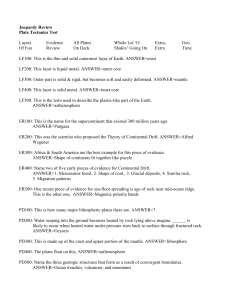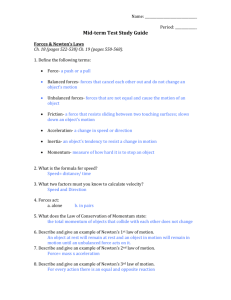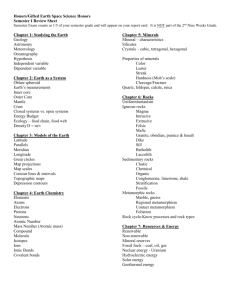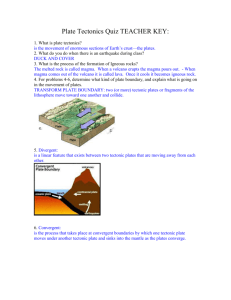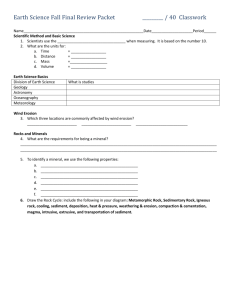2nd 9 Weeks Test Review
advertisement
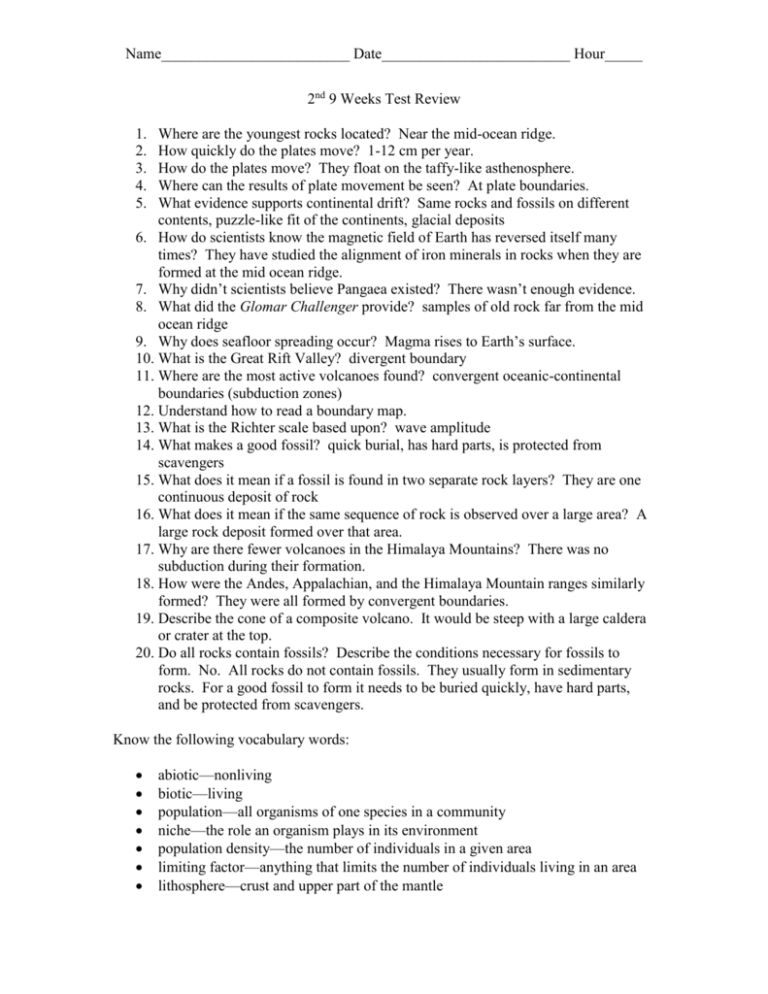
Name_________________________ Date_________________________ Hour_____ 2nd 9 Weeks Test Review 1. 2. 3. 4. 5. Where are the youngest rocks located? Near the mid-ocean ridge. How quickly do the plates move? 1-12 cm per year. How do the plates move? They float on the taffy-like asthenosphere. Where can the results of plate movement be seen? At plate boundaries. What evidence supports continental drift? Same rocks and fossils on different contents, puzzle-like fit of the continents, glacial deposits 6. How do scientists know the magnetic field of Earth has reversed itself many times? They have studied the alignment of iron minerals in rocks when they are formed at the mid ocean ridge. 7. Why didn’t scientists believe Pangaea existed? There wasn’t enough evidence. 8. What did the Glomar Challenger provide? samples of old rock far from the mid ocean ridge 9. Why does seafloor spreading occur? Magma rises to Earth’s surface. 10. What is the Great Rift Valley? divergent boundary 11. Where are the most active volcanoes found? convergent oceanic-continental boundaries (subduction zones) 12. Understand how to read a boundary map. 13. What is the Richter scale based upon? wave amplitude 14. What makes a good fossil? quick burial, has hard parts, is protected from scavengers 15. What does it mean if a fossil is found in two separate rock layers? They are one continuous deposit of rock 16. What does it mean if the same sequence of rock is observed over a large area? A large rock deposit formed over that area. 17. Why are there fewer volcanoes in the Himalaya Mountains? There was no subduction during their formation. 18. How were the Andes, Appalachian, and the Himalaya Mountain ranges similarly formed? They were all formed by convergent boundaries. 19. Describe the cone of a composite volcano. It would be steep with a large caldera or crater at the top. 20. Do all rocks contain fossils? Describe the conditions necessary for fossils to form. No. All rocks do not contain fossils. They usually form in sedimentary rocks. For a good fossil to form it needs to be buried quickly, have hard parts, and be protected from scavengers. Know the following vocabulary words: abiotic—nonliving biotic—living population—all organisms of one species in a community niche—the role an organism plays in its environment population density—the number of individuals in a given area limiting factor—anything that limits the number of individuals living in an area lithosphere—crust and upper part of the mantle Name_________________________ Date_________________________ Hour_____ asthenosphere—taffy-like lower part of the mantle continental drift—plates have moved slowly to their current locations convergent boundary—plates move together; mountains form divergent boundary—plates move apart; volcanoes form transform boundary—earthquakes occur subduction zone—convergent boundary where a denser plate sinks under a less dense plate convection currents—rising and sinking air that might drive plate tectonics seismic waves—earthquake waves tsunamis—big waves caused by earthquake motion on the ocean floor primary waves—the fastest and smallest waves secondary waves—the medium sized waves surface waves—the slowest and most damaging earthquake waves magma—molten rock beneath Earth’s surface lava—molten rock on Earth’s surface composite volcano—has a steep slope, explodes, and is made of layers cinder cone volcano—has a cone shape, made of hardened lava, and explodes shield volcano—is flat, oozes (erupts) with lava, and is made of layers relative dating—determining the order of events and the relative age of rocks by examining the position of rocks in a sequence unconformities—gaps on rock layers principle of superposition—in undisturbed rock, the bottom layer of rock is the oldest, and the rocks get gradually younger eon—the longest subdivision of geologic time metamorphic rocks—form from heat and pressure igneous rocks—form from cooled magma sedimentary rocks form from compaction and cementation
